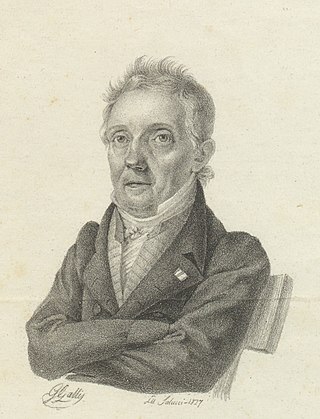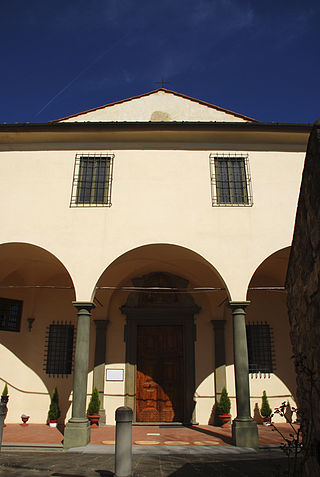
Sant'Apollonia was a former Benedictine convent, founded in 1339, just north of the center of Florence, in Italy.

The Teatro Alfieri was a major theatre and opera house in 18th and 19th century Florence, located at Via dell'Ulivo #6 corner Via Pietrapiana in the Florence, region of Tuscany, Italy.

The Teatro Capranica is a theatre situated at 101 Piazza Capranica in the Colonna district of Rome. Originally constructed in 1679 by the Capranica family and housed in the early Renaissance Palazzo Capranica, it was the second public theatre to open in Rome. It was the site of many premieres of Baroque operas including Caldara's Tito e Berenice, Scarlatti's Griselda, and Vivaldi's Ercole su'l Termodonte. The Capranica ceased operating as a full-scale theatre and opera house in 1881 and in 1922 was converted into a cinema. Following the closure of the cinema in 2000, it has functioned on a hire basis as a conference and performance venue.
Pier Maria Baldi was an Italian painter and architect.
The following is a timeline of the history of the city of Florence, Tuscany, Italy.

The Palazzo Giugni, also called the Palazzo Firenzuola, is a late-Renaissance or Mannerist architecture palace designed by Bartolomeo Ammanati, and located on Via degli Alfani #48 in the quartiere San Giovanni of Florence, region of Tuscany, Italy. It is located down the street from the Brunelleschi's church of Santa Maria degli Angeli.

The Palazzo Rinuccini is a palace located on Via Santo Spirito #39 in central Florence, region of Tuscany Italy.

Giuseppe Del Rosso was an architect and architectural writer mainly in late 18th and early 19th-century Florence and Tuscany. He became a collaborator with Marco Lastri in the editorship of a 6 volume set of observations on cultural monuments and buildings in Florence, which proved as a guide, sometimes anecdotal, for the sophisticated foreign travelers, titled L'Osservatore fiorentino sugli edifizj della sua patria.
The Pia Casa di Lavoro di Montedomini is a large complex of buildings in Florence, Italy; the complex took shape in 1812, on the site of two expropriated former monasteries, where the Napoleonic government built a poor-house. The complex is bound by Via dei Malcontenti, Via delle Casine, Via Pietro Thouar and the Viale della Giovine Italia. The complex is located in the quartiere of Santa Croce, east of the city, north of the Arno river, and just within the 16th-century city walls.

The Column of Santa Felicita is a monumental column with Corinthian capital standing in front of the church of Santa Felicita in Florence, region of Tuscany, Italy.

Santa Maria degli Angiolini, also known as the Capella degli Angioli, is a Renaissance-style, Roman Catholic church, located on Via della Colonna #34, now serving as a school and dormitory.

The Porta Romana, once known as the Porta San Pier Gattolino was the southernmost gate in the 13th-century walls of the Oltrarno section of Florence, region of Tuscany, Italy. It stands at the confluence of a number of roads: accessed from north by Via Romana, Via de' Serragli, and Viale Francesco Petrarca. In addition, a central road along the Boboli Gardens begins near the gate, and allowed the inhabitants of the Pitti Palace to exit and enter Florence with minimal travel on city streets. Beyond the gates are the Via del Poggio Imperiale and Via Senese. The latter led to Siena and points south such as Rome, hence the name. When the majority of the defensive walls of Florence were razed in the 19th century, only a few, and sometimes partial gate structures were left standing including San Gallo Gate, Tower of San Niccolò, and this gate with a snippet of merlonated wall.

Monastero delle Murate is a former Benedictine convent on Via Ghibellina in Florence, Italy. For about a hundred years, from 1883 to 1985, it was the men's prison in Florence, after which the detainees were transferred to Sollicciano and other facilities. Since the 21st century, it has served as a restaurant and meeting places, with additional apartments, bars, restaurants and shops. The religious community dates to 1370 when 12 women became voluntarily reclusive in a shack by the second pillar of the Ponte Rubaconte, praying and living on alms in extremely difficult conditions. Given the growth in the number of sisters, in 1424, Giovanni de 'Benci, who lived nearby, financed the construction of a new, larger monastery near the walls, called the Most Holy Annunciation and St. Catherine. The monastery was renovated and expanded for the first time in 1471, following a fire, and then in 1571, after a flood. Supporters included Lorenzo de' Medici. Also in 1509 Caterina Sforza was buried in the monastery.

The two fontane dei mostri marini are located in the Santissima Annunziata plaza in the Italian city of Florence.

The Stinche Prison was a prison on Via Ghibellina in the city of Florence, Italy. It stood more or less on the site now occupied by the Teatro Verdi.

Santa Maria e Santa Brigida al Paradiso is a Roman Catholic parish church located on via Benedetto Fortini in the quatiere of Gavinana in the zone of Paradiso, just south of the urban center of Florence, region of Tuscany, Italy. The church is also known as Santi Maria e Brigida alla Badiuzza di Fabroro

Santa Maria della Neve al Portico is a Roman Catholic church and convent located on a rural site on Via del Podestà #86 in the suburban neighborhood of Galluzzo southeast of the urban center of Florence, Italy. It remains a monastery and is also known as the Convento Il Portico and now houses the Istituti Religiosi Femminili Suore Stimmatine.

Florentia was a Roman city in the Arno valley from which Florence originated. According to tradition, it was built by the legions of Gaius Julius Caesar in 59 BC; however, the prevailing hypothesis dates the foundation of the city to the Augustan period.

The former Collegio degli Scolopi is a large building in Florence, annexed to the church of San Giovanni degli Scolopi and located between via de 'Martelli, via dei Gori, Piazza San Lorenzo and Borgo San Lorenzo. Formerly the palace of the Martelli family, it was the seat of the Jesuit order, designed on a grand scale by Bartolomeo Ammannati, then housed the college of the Piarists and finally, after the suppression of the convents, it became a school. Today most of its rooms are occupied by the Galileo state classical high school, but in one part there is also the Ximenian observatory, with access from the rear Borgo San Lorenzo.
















